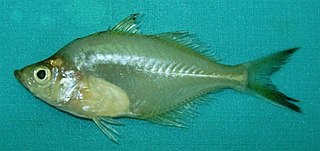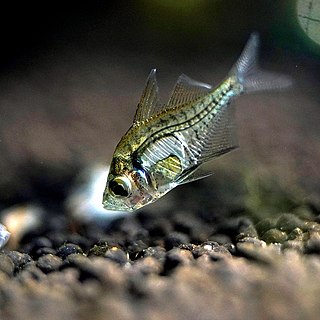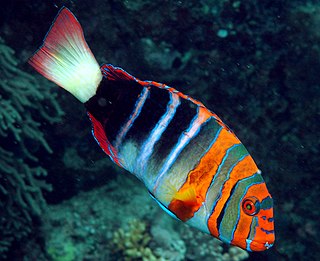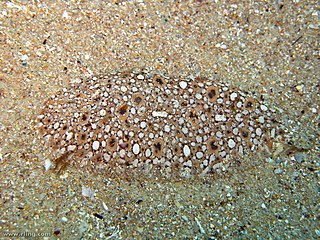
Cirrhitidae, the hawkfishes, are a family of marine perciform ray-finned fishes found in tropical seas and which are associated with coral reefs.

The elongate glassy perchlet is a species of freshwater fish in the Asiatic glassfish family Ambassidae of order Perciformes, the only species in the genus Chanda. It is native to an area of south Asia from Pakistan to Burma, in the Indomalayan realm.

Parambassis is a genus of freshwater fish in the Asiatic glassfish family Ambassidae of order Perciformes. The type species is the Iridescent glassy perchlet. These fishes originate mostly from Southeast Asia, but the species range across the Indomalayan and Australasian realms, from Pakistan, China and India south through Indonesia, New Guinea and Australia. Although primiarly found in fresh water, a few species can also be seen in brackish water. The Parambassis species range in maximum size from 4–24 cm (1.5–9.5 in), but they are similar in appearance, with a lozenge-shaped form, typical perciform fins, and semitransparent or transparent body. Several of the species are common food fish in local markets, and some are kept as aquarium fish.

The Carangidae are a family of ray-finned fish that includes the jacks, pompanos, jack mackerels, runners, trevallies, and scads. It is the largest of the six families included within the order Carangiformes. Some authorities classify it as the only family within that order but molecular and anatomical studies indicate that there is a close relationship between this family and the five former Perciform families which make up the Carangiformes.

Choerodon is a genus of wrasses native to the Indian Ocean and the western Pacific Ocean. They are commonly referred to as tuskfish, because most species have sharp tusk-like teeth.

Sardinella is a genus of fish in the family Dorosomatidae found in the Atlantic, Indian and Pacific Ocean. They are abundant in warmer waters of the tropical and subtropical oceans. Adults are generally coastal, schooling, marine fish but juveniles are often found in lagoons and estuaries. These species are distinguished by their ranges and by specific body features, but they are often confused with one another. Fish of the genus have seven to 14 striped markings along the scales of the top of the head. The paddle-shaped supramaxilla bones are characteristic; they separate Sardinella from other genera and their shapes help distinguish species. They have paired predorsal scales and enlarged fin rays.

Sargocentron is a genus of squirrelfish found in tropical parts of the Indian, Pacific and Atlantic Oceans, with the greatest species diversity near reefs in the Indo-Pacific. Being largely or entirely nocturnal, they have relatively large eyes. Red and silvery colours dominate. The preopercle spines are venomous and can give painful wounds. Most have a maximum length of 15–25 cm (6–10 in), but S. iota barely reaches 8 cm (3 in), and S. spiniferum can reach more than 50 cm (20 in).

Myripristis is a genus of soldierfishes.

Plectorhinchus is a genus of marine ray-finned fish, sweetlips belonging to the subfamily Plectorhinchinae which is one of two subfamilies in the family Haemulidae which also includes the grunts. The species in this genus are found in fresh, brackish, and salt waters.

Agassiz's perchlet, also known as Agassiz's glass fish and the olive perchlet, is a species of ray-finned fish in the family Ambassidae. It is semi-transparent with dark scale edges forming a pattern over most of the body. It grows to a maximum of 7.5 cm. It is a macrophyte spawner with adhesive eggs. It is endemic to Australia. It was named for the zoologist Louis Agassiz.

Cephalopholis is a genus of marine ray-finned fish, groupers from the subfamily Epinephelinae in the family Serranidae, which also includes the anthias and sea basses. Many of the species have the word "hind" as part of their common name in English.
Tetracentrum is a genus of fish in the family Ambassidae, the Asiatic glassfishes. They are all native to freshwater in New Guinea.

Tylosurus is a genus of needlefish, one of ten in the family Belonidae. They are found worldwide in tropical and warmer temperate seas and two species have been recorded as Lessepsian migrants in the eastern Mediterranean Sea.

Pardachirus is a genus of soles mainly native to coastal water in the Indo-Pacific. A single species, P. poropterus is restricted to estuaries and lower sections of freshwater streams. At least some species in the genus are toxic.
Ambassis marianus, commonly known as the estuary perchlet, Ramsay's glassfish, estuary glassfish or glass perchlet, is a species of fish in the family Ambassidae. It is native to coastal eastern Australia. It gains its common name from its transparent appearance.

Ambassis macleayi, commonly known as Macleay's glassfish, Macleay's glass perchlet, Macleay's perchlet, reticulated glassfish, reticulated perchlet, or network perchlet, is a species of freshwater fish in the family Ambassidae. It is native to northern Australia and the trans-Fly River region of New Guinea. It is a fish with a vertically flat, narrow body and a standard length generally between 35 and 45 mm, with large specimens reaching 77 mm (3.0 in) long. It generally eats water fleas and other small invertebrates. This fish is considered to be a least-concern species according to the International Union for Conservation of Nature (IUCN), although it could suffer from habitat degradation due to feral pigs and invasive water plants such as the water hyacinth. The fish is suitable for aquarium use in tanks containing other non-aggressive species.

Ambassis nalua, the scalloped glassfish or scalloped perchlet, is a species of fish in the genus Ambassis. It is native to the Indo-Pacific region, form India to Australia and New Guinea, where it occurs in bays, estuaries and mangrove-lined creeks.

Parambassis wolffii, commonly known as the duskyfin glassy perchlet, is a species of freshwater fish in the Asiatic glassfish family Ambassidae of order Perciformes. It is native to Thailand and Indonesia. The specific name honours Bleeker's friend, the military surgeon Wolff.

Ambassis jacksoniensis, commonly known as the Port Jackson glassfish or Port Jackson perchlet, is a species of fish in the family Ambassidae native to eastern Australia. It gains its common name from its transparent appearance.

















